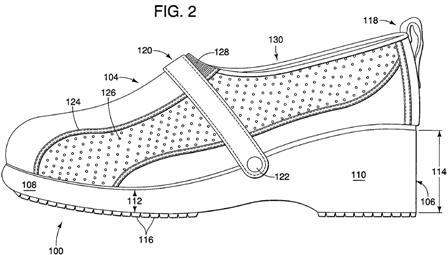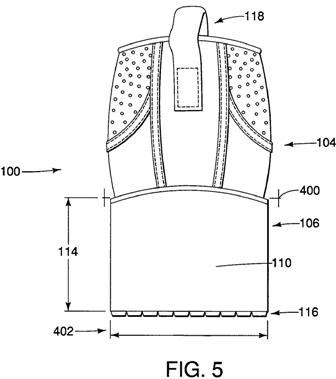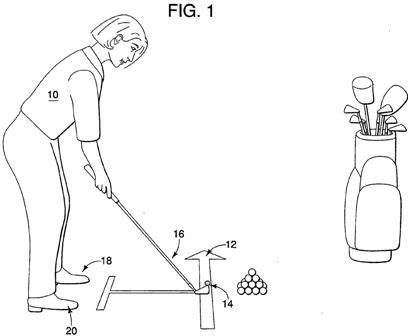Does the World Really Need High Heel Golf Shoes?
That is a tough question because most of my annual golf spending is on products that I don’t really need. Heck, high heel golf shoes may do more for my actual game than many of the products that I purchase. Regardless, recently an interesting (I can’t bring myself to say “unique”) patent application was published as US Pub. No. 20100242307 titled “Golf Shoe,” which is directed to high heel golf shoes. Check out these beauties!



The application explains:
[0010] As golf becomes more accessible, individuals are increasingly forming small relaxed social golfing groups that are focused more on socializing and less on formal golf rules. Women are also increasingly entering the sport as a social activity and have particular interest in golf equipment that addresses their particular needs.
[0011] We disclose shoes that are designed for orienting the feet in a particular manner, such as to improve the golf stance and golf swing. The shoes have a sole. The sole has a front portion that corresponds to the toes of a foot and a back portion that corresponds to the heel of a foot. The shoe also includes an upper portion that is coupled to the sole. The upper portion of the shoe is sized to receive a foot.
[0012] The shoe may position the foot such that the heel of the foot is elevated to a height above the front or toes of the foot. By elevating the heel of the foot above the toes, a golfer may be able to create the proper knee flex, while easing the weight transfer needed to make an athletic move, thereby enhancing contact and swing.
[0013] When swinging a golf club, many factors contribute to the quality of the swing. For example, the stance, the proper arm positioning throughout the swing, the grip, the dynamics of the swinging motion, and the tempo all contribute to the quality of the swing.
[0014] One aspect of a golf swing is the proper foot stance and how to maintain the proper foot stance throughout the swing. FIG. 1 shows a golfer 10 performing a typical golf stance. A golfer 10 typically begins the swing with the legs apart and the body (e.g., feet, knees, hips, forearms, shoulders, and eyes) positioned parallel to the target line 12. The target line 12 is the desired path that the ball 14 will take when struck by the golf club 16. The feet are typically spread apart with an approximately equal distance between each foot and the ball 14 (e.g., the ball 14 forward and/or centered between the feet). The foot that is closest to the direction that the ball will travel may be referred to as the front foot 18. The foot that is farthest away may be referred to as the back foot 20.
[0015] The golf swing involves a complex rotation of the body aimed at accelerating the head of the golf club 16 to a great speed at the target, or golf ball 14. For a right handed golfer 10, the golf swing includes of a backswing to the right, a downswing to the left, and a follow through. The ball 14 is hit during the downswing. During the backswing, the torso begins to turn. The golfer’s legs, which may be positioned such that the left foot is the front foot 18 and the right foot is the back foot 20, resist the rotation, creating torque between the lower and upper body. As the body continues to turn into the back swing, up to 75 percent of the golfer’s body weight may be transferred to the back foot 20, in this case, the right foot. During the transition from backswing to downswing, weight is transferred from the heel of the back foot 20 to the toes of the front foot 18, and the hips may begin to uncoil and open up. The golfer may push against the ground for added power through the downswing, which may create a more solid foundation creating greater club head speed.
[0016] A left handed golfer 10 swings back to the left and forward to the right, a downswing to the left, and a follow through. The ball 14 is hit during the downswing. During the backswing, the torso begins to turn. The golfer’s legs, which may be positioned such that the right foot is the front foot 18 and the left foot is the back foot 20, resist the rotation, creating torque between the lower and upper body. As the body continues to turn into the back swing, up to 75 percent of the golfer’s body weight may be transferred to the back foot 20, in this case, the left foot. During the transition from backswing to downswing, weight is transferred from the heel of the back foot 20 to the toes of the front foot 18, and the hips may begin to rotate down the line toward the ball.
[0017] With the shoe FIG. 2, 100 the golfer may improve over a standard golf shoe, the ability to maintain a more effective weight distribution (e.g., weight on the heels during upswing and on the toes during downswing), spine angle, and knee flex during the set up and throughout the golf swing. For example, as the body turns into the backswing and the weight shifts back into the heels of the foot, the elevated heel of the shoe FIG. 2, 100 may create a solid foundation for the golfer’s weight. The angle of the shoe, slanting down from the back to the front, may facilitate weight transfer from the heels to the toes at impact. The elevation and support provided by the shoe may compensate for any lack of flexibility, strength, and/or consistency in, for example, amateur players, older players, less athletic players, and others.
[0018] The shoe 100 may, by improving the performance of golfers, including less athletic, experienced, or traditional golfers, make the game of golf accessible and enjoyable to a wider range of individuals. For example, elevating the heel at impact may improve the golfer’s ability to make a stronger move at the ball 14 on the downswing which may result in improving the golfer’s contact with the ball 14. Additionally, the elevated heel of the shoe 100 may create flex in the knees which may further create torque during the backswing and may eliminate locking of the back leg. The knee flex and resulting torque may allow the golfer to assume a more athletic position to make a stronger move toward the ball 14 than if the weight was maintained differently, for example, with both feet flat on the ground or weight positioned more heavily on either front or back foot.
[0019] The shoe FIG. 2, 100 may also prove useful to seasoned golfers who are seeking to improve their foot stance and thus, their swing. Placing the weight on the front of the feet is an unnatural activity. As such, golfers often forget and stand flat footed as they swing. The result is a less than ideal swing. When out on the golf course or practice range, it is not practical to place an object under the foot to approximate the appropriate stance for every swing. Due to changes in surface contours and surface type, a golfer often changes the position of his/her feet several times prior to swinging. Using foreign objects under the shoe is useful only when practicing and not permitted during actual play.
[0020] FIG. 2 illustrates a first side of a golf shoe 100. The golf shoe 100 has a sole 106 and an upper portion 104 that is coupled to the sole 106. The upper portion 104 may be sized to receive a foot. The upper may have an opening 130 for receiving a foot. The sole 106 may have a front portion 108 and a rear portion 110. The front portion 108 may correspond to the toes of the human foot. The rear portion 110 may correspond to the heel of the human foot.
[0021] The sole 106 may have an elevation, for example, an elevation at the front of the foot 112 and an elevation at the heel of the foot 114. The sole 106 may vary in elevation along its length from the front portion 108 to the rear portion 110. For example, the rear portion 110 may be elevated and may taper toward the front portion 108. More specifically, the rear portion 110 may have an elevation 114 which is greater than the elevation 112 of the front portion 108, for example, the rear portion 110 may have an elevation of approximately 0.50 inches to approximately 5 inches, or may have a elevation of approximately 1.0 inches to approximately 3.0 inches, or may have a elevation of approximately 1.5 inches to approximately 2.5 inches, in each case the elevation of the rear portion 110 exceeding the elevation of the front portion 108. As an example, the elevation of the rear portion 110 may exceed the elevation of the front portion 108 by about 25%. In that case, if the elevation of the front portion 108 is 0.5 inches, the elevation of the rear portion 110 may be about 0.625 inches. However, a ratio of front portion 108 to rear portion 110 may change depending on implementation. The ratio of front portion 108 to rear portion 110 may be any ratio as long as the rear portion 110 is of greater elevation than the front portion 108. The sole 106 may be continuous or may be discontinuous, for example, the front portion 108 and the rear portion 110 may be on one continuous piece or more than one piece, which pieces may be joined together or otherwise attached to the upper portion 104.
[0022] When the shoe 100 is worn by a golfer, the elevation of the rear portion 110 above the front portion 108 may elevate the heel of the foot above the front of the foot. Having the heels elevated at impact may improve the golfer’s ability to make a stronger move at the ball on the down swing which may result in improving the golfer’s contact with the ball. Additionally, having the heels elevated may create flex in the knees which may create further torque during the backswing and may eliminate locking of the back leg.
Care to make a prediction on whether this application ever matures to a patent? My money is on “NO.” The shoes actually look a little dangerous to me, but then again I don’t quite have a perfectly balanced and smooth swing! Anyone up for a round of golf in 5″ heels?
David Dawsey – Watching Shoe Inventions
PS – click here to check out another interesting golf shoe invention
